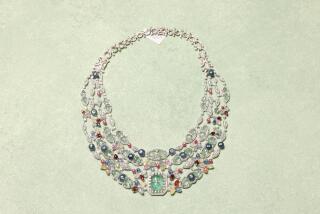THE CUTTING EDGE: COMPUTING / TECHNOLOGY / INNOVATION : Hunt for Suspect Stones Helped by Technology
- Share via
What do the U.S. Treasury and Indian jewelry makers have in common? A problem with counterfeiting. And both now have a possible solution in the form of a technology developed by Los Alamos National Laboratory researcher Don Burns.
As part of its nuclear waste management efforts, the lab has been honing a tool called near-infrared spectroscopy for analyzing plastics and rubber in radioactive waste. Light that is just beyond the visible spectrum is shined through a fiber-optic cable onto a suspect sample, which then reflects the light back to sensors. The sensors feed the information to a monochromator, and then to a computer.
The monochromator acts like a prism, breaking up the light into wavelengths. The makeup of every material creates its own reflectance pattern, much like a fingerprint. The computer than analyzes this pattern against stored patterns of the genuine article.
Burns has applied for a patent to use near-infrared spectroscopy to distinguish the genuine from the fake, and he is initially concentrating on money and turquoise Indian jewelry, which is increasingly a target of counterfeiters. The technique could eventually be used to determine the authenticity of almost any substance.
*
Here’s the Rub: Liquid crystal displays are used in everything from portable computers to watches and airplane cockpit displays, and a new discovery about how they function could eventually lead to better, cheaper displays.
Since 1911, scientists have known that the way to turn the raw liquid crystal material into a surface capable of displaying an image is to give the base material--usually some form of plastic--onto which the liquid crystal is placed a good rub. The rubbing alters the surface and causes the liquid crystal molecules, which in their natural state are oriented in many directions, to align themselves in neat rows--a crucial prerequisite to their displaying an image. Until recently, though, no one knew why rubbing caused the molecules to behave this way.
Now a team of scientists at IBM and Pennslyvania State University have solved this mystery. They discovered that even a single swipe with a soft cloth over a hard, glassy polymer film similar to that used as a base for LCD’s was enough to cause a realignment of its surface molecules, much like we smooth our hair with the palm of our hand. It is this “molecular template” that causes the liquid crystal molecules to behave as they do.
Researchers found it remarkable that a light rub could rearrange the molecules of a hard polymer. With this information, it might be possible to make displays that use thinner LCD films, have faster response and produce a clearer image.





